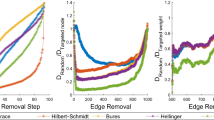Abstract
We extend the Czekanowski-Dice dissimilarity measure, classically used to cluster the vertices of unweighted graphs, to weighted ones. The first proposed formula corresponds to edges weighted by a probability of existence. The second one is adapted to edges weighted by intensity or strength. We show on simulated graphs that the class identification process is improved by computing weighted compared to unweighted edges. Finally, an application to a drosophila protein network illustrates the fact that using these new formulas improves the ’biological accuracy’ of partitioning.
Similar content being viewed by others
References
Andjilani M, Droz JP, Benahmed M and Tabone E (2006). Down-regulation of fak and iaps by laminin during cisplatin-induced apoptosis in testicular germ cell tumors. Int J Oncol 28(2): 535–542
Bader GD and Hogue CW (2003). An automated method for finding molecular complexes in large protein interaction networks. BMC Bioinf 4: 2
Baudot A, Martin O, Mouren P, Chevenet F, Guénoche A, Jacq B and Brun C (2006). Prodistin web site: a tool for the functional classification of proteins from interaction networks. BMC Bioinf 22(2): 248–250
Baudot A, Jacq B and Brun C (2004). A scale of functional divergence for yeast duplicated genes revealed from the analysis of the protein–protein interaction network. Genome Biol 5: R76
Brandes U, Gaertler M, Wagner D (2003) Experiments on graph clustering algorithms. In: Di Battista G, Zwick U (eds) ESA 2003. LNCS, vol 2832. Springer, Heidelberg, pp 568–579
Brun C, Chevenet F, Martin D, Wojcik J, Guénoche A and Jacq B (2003). Functional classification of proteins for the prediction of cellular function from a protein–protein interaction network. Genome Biol 5: R6
Brun C, Herrmann C and Guénoche A (2004). Clustering proteins from interaction networks for the prediction of cellular functions. BMC Bioinf 5: 95
Charon I, Denoed L, Guénoche A and Hudry O (2006). Maximum transfer distance between partitions. J Classif 23(1): 103–121
Chen J, Chua HN, Hsu W, Lee ML, Ng SK, Saito R, Sung WK and Wong L (2006). Increasing confidence of protein–protein interactomes. Genome Inf 17(2): 284–297
Chua HN, Sung WK and Wong L (2006). Exploiting indirect neighbours and topological weight to predict protein function from protein-protein interactions. Bioinformatics 22(13): 1623–1630
Day W (1981). The complexity of computing metric distances between partitions. Math Soc Sci 1: 269–287
Dice LR (1945). Measures of the amount of ecologic association between species. Ecology 26(3): 297–302
van Dongen S (2000) Graph clustering by flow simulation. Ph.D. Thesis, University of Utrecht
Fichet B and Le Calvé G (1984). Structure géometrique des principaux indices de dissimilarité sur signes de présence–absence. Stat Anal Donnés 3: 11–44
Formstecher E, Arresta S, Collura V, Hamberger A, Meil A, Trehin A, Reverdy C, Betin V, Maire S, Brun C, Jacq B, Arpin M, Bellaiche Y, Bellusci S, Benaroch P, Bornens M, Chanet R, Chavrier P, Delattre O, Doye V, Fehon R, Faye G, Galli T, Girault JA, Goud B, Johannes L, Junier MP, Mirouse V, Mukherjee A, Papadopoulo D, Perez F, Plessis A, Rosbach M, Ross C, Saule S, Stoppa-Lyonnet D, Vincent A, White M, Legrain P, Wojcik J, Camonis J, Daviet L and Gunzburg J (2005). Protein interaction mapping: a drosophila case study. Genome Res 15: 376–384
Gascuel O (1997). BioNJ: an improved version of the nj algorithm based on a simple model of sequence data. Mol Biol Evol 14(7): 685–695
Girvan M and Newman MEJ (2002). Community structure in social and biological networks. Proc Natl Acad Sci USA 99(12): 7821–7826
Guénoche A (2004) Clustering by vertex density in a graph. In: Banks D et al Proceedings of IFCS congress classification, clustering and data mining applications. Springer, Berlin, pp 14–24
Guénoche A (2005) Comparing recent methods in graph partitioning. ICGT’05. Electronic notes in discrete mathematics, vol 22, pp 83–89
Guénoche A (2008) Comparison of algorithms in graph partitioning. RAIRO (to appear)
Kuntz P (1992) Représentation euclidienne d’un graphe abstrait en vue de sa segmentation. Ph.D. Thesis, Ecole des Hautes Etudes en Sciences Sociales, Paris
Nemwan MEJ (2006). Modularity and community structure in networks. PNAS 103(23): 8577–8582
Pons P and Latapy M (2006). Computing communities in large networks using random walks. J Graph Algorithms Appl 10(2): 191–218
Régnier S (1965) Quelques aspects mathématiques des problèmes de classification automatique. ICC Bull 4, reprint (1983) Math Sci Hum 82:13–29
Zhong W and Sternberg PW (2006). Genome-wide prediction of C. elegans genetic interactions. Science 318: 1481–1484
Author information
Authors and Affiliations
Corresponding author
Rights and permissions
About this article
Cite this article
Angelelli, JB., Baudot, A., Brun, C. et al. Two local dissimilarity measures for weighted graphs with application to protein interaction networks. ADAC 2, 3–16 (2008). https://doi.org/10.1007/s11634-008-0018-3
Received:
Revised:
Accepted:
Published:
Issue Date:
DOI: https://doi.org/10.1007/s11634-008-0018-3




